Leadership, Ethics, and the Bottle Shock Exercise: A Business Report
VerifiedAdded on 2020/05/11
|10
|3271
|76
Report
AI Summary
This report provides a comprehensive analysis of business ethics and leadership, utilizing the "Bottle Shock" exercise as a case study to explore ethical dilemmas and leadership styles. The introduction defines leadership and its importance in guiding organizations, emphasizing the need for ethical decision-making. The report examines the scenario of a product recall involving baby bottles, analyzing the engineering department's response and the ethical considerations surrounding the decision-making process. It evaluates different leadership approaches, contrasting effective and ineffective styles. The report emphasizes the critical role of leaders in establishing goals, motivating employees, and fostering a positive work environment. It also highlights the importance of moral and legal responsibilities within a business context. The analysis includes discussions on how leadership can influence team morale, decision-making, and overall organizational success, as well as a critique of the leadership exhibited in the Bottle Shock exercise. Furthermore, the report stresses the importance of fostering the growth of team members and the need for leaders to possess decisiveness, focus, awareness, accountability, and empathy.
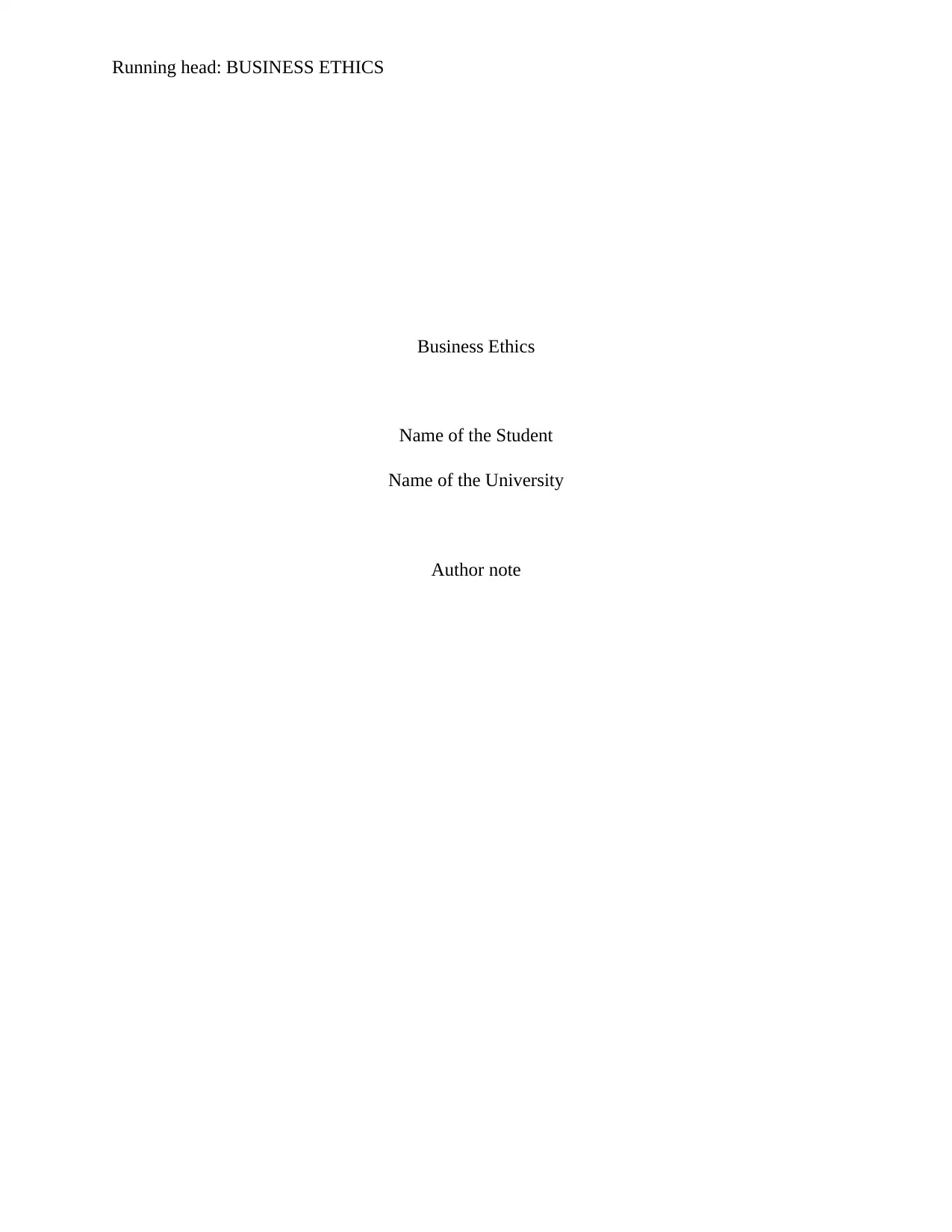
Running head: BUSINESS ETHICS
Business Ethics
Name of the Student
Name of the University
Author note
Business Ethics
Name of the Student
Name of the University
Author note
Paraphrase This Document
Need a fresh take? Get an instant paraphrase of this document with our AI Paraphraser
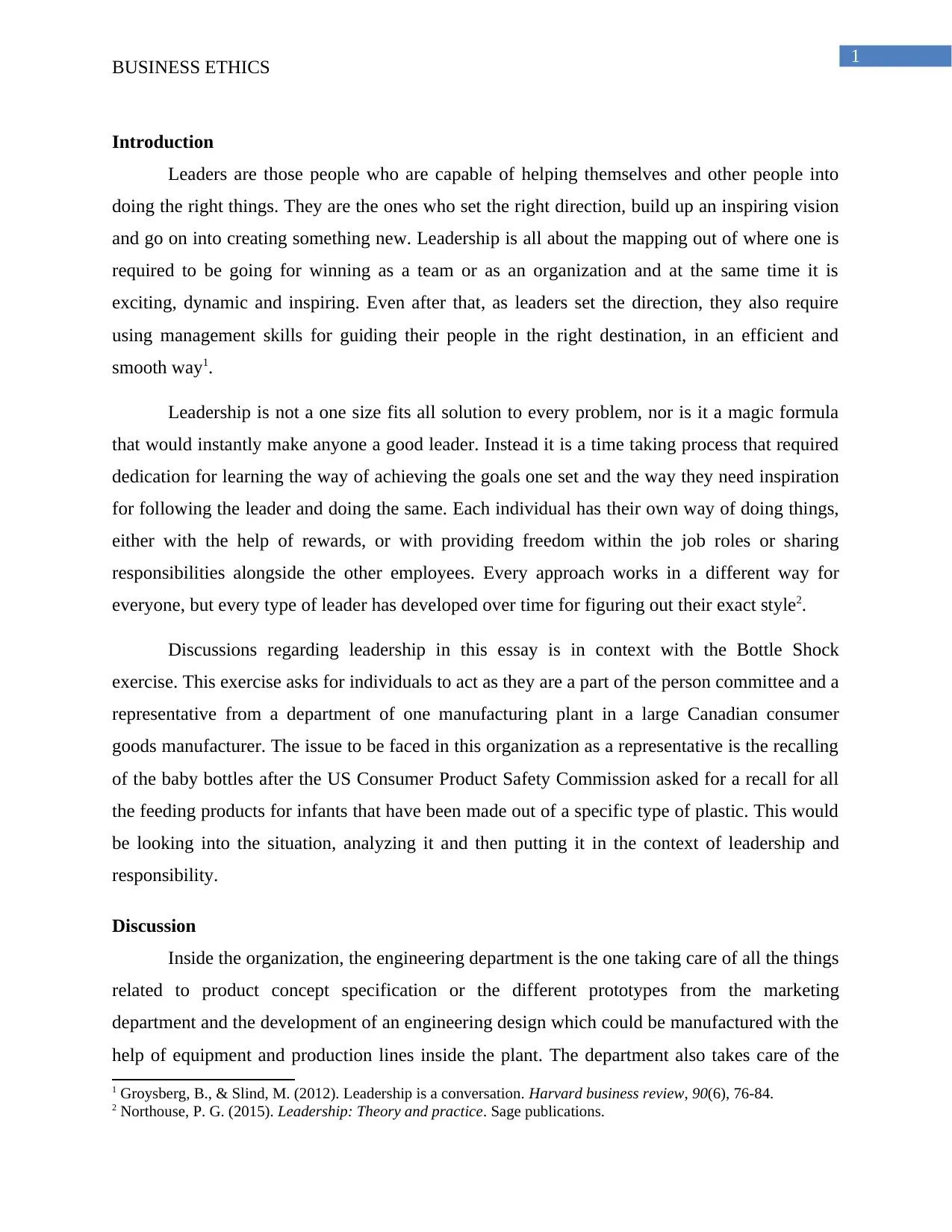
1
BUSINESS ETHICS
Introduction
Leaders are those people who are capable of helping themselves and other people into
doing the right things. They are the ones who set the right direction, build up an inspiring vision
and go on into creating something new. Leadership is all about the mapping out of where one is
required to be going for winning as a team or as an organization and at the same time it is
exciting, dynamic and inspiring. Even after that, as leaders set the direction, they also require
using management skills for guiding their people in the right destination, in an efficient and
smooth way1.
Leadership is not a one size fits all solution to every problem, nor is it a magic formula
that would instantly make anyone a good leader. Instead it is a time taking process that required
dedication for learning the way of achieving the goals one set and the way they need inspiration
for following the leader and doing the same. Each individual has their own way of doing things,
either with the help of rewards, or with providing freedom within the job roles or sharing
responsibilities alongside the other employees. Every approach works in a different way for
everyone, but every type of leader has developed over time for figuring out their exact style2.
Discussions regarding leadership in this essay is in context with the Bottle Shock
exercise. This exercise asks for individuals to act as they are a part of the person committee and a
representative from a department of one manufacturing plant in a large Canadian consumer
goods manufacturer. The issue to be faced in this organization as a representative is the recalling
of the baby bottles after the US Consumer Product Safety Commission asked for a recall for all
the feeding products for infants that have been made out of a specific type of plastic. This would
be looking into the situation, analyzing it and then putting it in the context of leadership and
responsibility.
Discussion
Inside the organization, the engineering department is the one taking care of all the things
related to product concept specification or the different prototypes from the marketing
department and the development of an engineering design which could be manufactured with the
help of equipment and production lines inside the plant. The department also takes care of the
1 Groysberg, B., & Slind, M. (2012). Leadership is a conversation. Harvard business review, 90(6), 76-84.
2 Northouse, P. G. (2015). Leadership: Theory and practice. Sage publications.
BUSINESS ETHICS
Introduction
Leaders are those people who are capable of helping themselves and other people into
doing the right things. They are the ones who set the right direction, build up an inspiring vision
and go on into creating something new. Leadership is all about the mapping out of where one is
required to be going for winning as a team or as an organization and at the same time it is
exciting, dynamic and inspiring. Even after that, as leaders set the direction, they also require
using management skills for guiding their people in the right destination, in an efficient and
smooth way1.
Leadership is not a one size fits all solution to every problem, nor is it a magic formula
that would instantly make anyone a good leader. Instead it is a time taking process that required
dedication for learning the way of achieving the goals one set and the way they need inspiration
for following the leader and doing the same. Each individual has their own way of doing things,
either with the help of rewards, or with providing freedom within the job roles or sharing
responsibilities alongside the other employees. Every approach works in a different way for
everyone, but every type of leader has developed over time for figuring out their exact style2.
Discussions regarding leadership in this essay is in context with the Bottle Shock
exercise. This exercise asks for individuals to act as they are a part of the person committee and a
representative from a department of one manufacturing plant in a large Canadian consumer
goods manufacturer. The issue to be faced in this organization as a representative is the recalling
of the baby bottles after the US Consumer Product Safety Commission asked for a recall for all
the feeding products for infants that have been made out of a specific type of plastic. This would
be looking into the situation, analyzing it and then putting it in the context of leadership and
responsibility.
Discussion
Inside the organization, the engineering department is the one taking care of all the things
related to product concept specification or the different prototypes from the marketing
department and the development of an engineering design which could be manufactured with the
help of equipment and production lines inside the plant. The department also takes care of the
1 Groysberg, B., & Slind, M. (2012). Leadership is a conversation. Harvard business review, 90(6), 76-84.
2 Northouse, P. G. (2015). Leadership: Theory and practice. Sage publications.
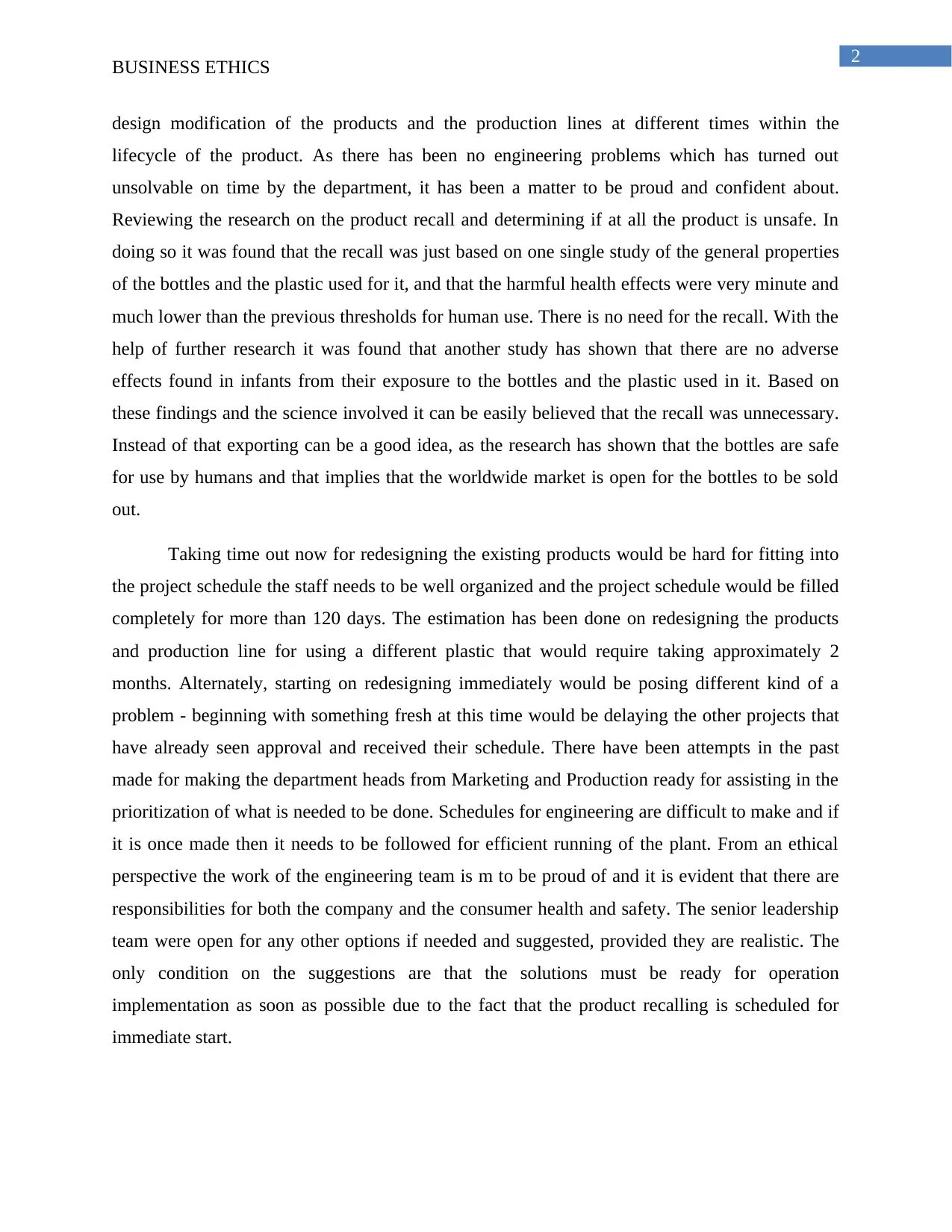
2
BUSINESS ETHICS
design modification of the products and the production lines at different times within the
lifecycle of the product. As there has been no engineering problems which has turned out
unsolvable on time by the department, it has been a matter to be proud and confident about.
Reviewing the research on the product recall and determining if at all the product is unsafe. In
doing so it was found that the recall was just based on one single study of the general properties
of the bottles and the plastic used for it, and that the harmful health effects were very minute and
much lower than the previous thresholds for human use. There is no need for the recall. With the
help of further research it was found that another study has shown that there are no adverse
effects found in infants from their exposure to the bottles and the plastic used in it. Based on
these findings and the science involved it can be easily believed that the recall was unnecessary.
Instead of that exporting can be a good idea, as the research has shown that the bottles are safe
for use by humans and that implies that the worldwide market is open for the bottles to be sold
out.
Taking time out now for redesigning the existing products would be hard for fitting into
the project schedule the staff needs to be well organized and the project schedule would be filled
completely for more than 120 days. The estimation has been done on redesigning the products
and production line for using a different plastic that would require taking approximately 2
months. Alternately, starting on redesigning immediately would be posing different kind of a
problem - beginning with something fresh at this time would be delaying the other projects that
have already seen approval and received their schedule. There have been attempts in the past
made for making the department heads from Marketing and Production ready for assisting in the
prioritization of what is needed to be done. Schedules for engineering are difficult to make and if
it is once made then it needs to be followed for efficient running of the plant. From an ethical
perspective the work of the engineering team is m to be proud of and it is evident that there are
responsibilities for both the company and the consumer health and safety. The senior leadership
team were open for any other options if needed and suggested, provided they are realistic. The
only condition on the suggestions are that the solutions must be ready for operation
implementation as soon as possible due to the fact that the product recalling is scheduled for
immediate start.
BUSINESS ETHICS
design modification of the products and the production lines at different times within the
lifecycle of the product. As there has been no engineering problems which has turned out
unsolvable on time by the department, it has been a matter to be proud and confident about.
Reviewing the research on the product recall and determining if at all the product is unsafe. In
doing so it was found that the recall was just based on one single study of the general properties
of the bottles and the plastic used for it, and that the harmful health effects were very minute and
much lower than the previous thresholds for human use. There is no need for the recall. With the
help of further research it was found that another study has shown that there are no adverse
effects found in infants from their exposure to the bottles and the plastic used in it. Based on
these findings and the science involved it can be easily believed that the recall was unnecessary.
Instead of that exporting can be a good idea, as the research has shown that the bottles are safe
for use by humans and that implies that the worldwide market is open for the bottles to be sold
out.
Taking time out now for redesigning the existing products would be hard for fitting into
the project schedule the staff needs to be well organized and the project schedule would be filled
completely for more than 120 days. The estimation has been done on redesigning the products
and production line for using a different plastic that would require taking approximately 2
months. Alternately, starting on redesigning immediately would be posing different kind of a
problem - beginning with something fresh at this time would be delaying the other projects that
have already seen approval and received their schedule. There have been attempts in the past
made for making the department heads from Marketing and Production ready for assisting in the
prioritization of what is needed to be done. Schedules for engineering are difficult to make and if
it is once made then it needs to be followed for efficient running of the plant. From an ethical
perspective the work of the engineering team is m to be proud of and it is evident that there are
responsibilities for both the company and the consumer health and safety. The senior leadership
team were open for any other options if needed and suggested, provided they are realistic. The
only condition on the suggestions are that the solutions must be ready for operation
implementation as soon as possible due to the fact that the product recalling is scheduled for
immediate start.
⊘ This is a preview!⊘
Do you want full access?
Subscribe today to unlock all pages.

Trusted by 1+ million students worldwide
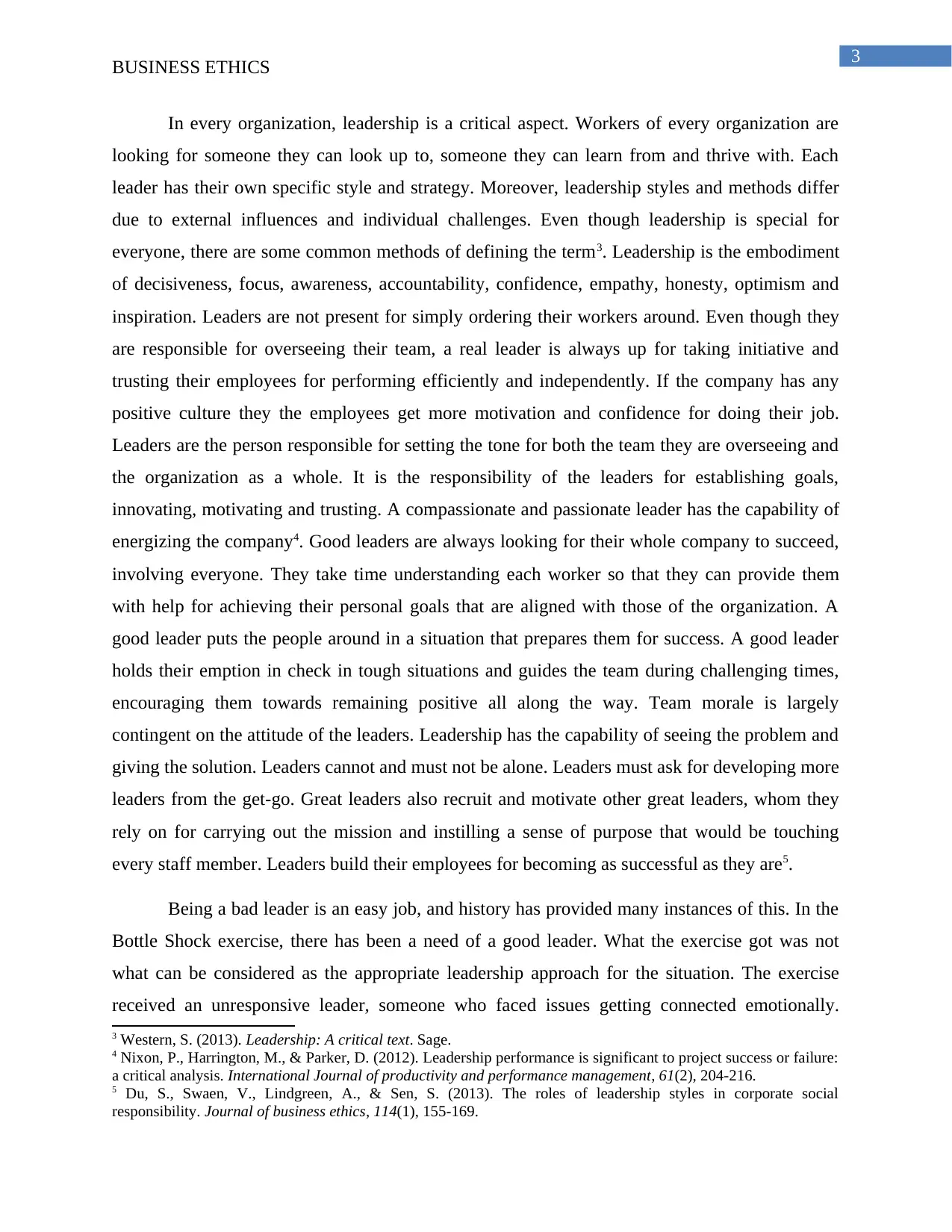
3
BUSINESS ETHICS
In every organization, leadership is a critical aspect. Workers of every organization are
looking for someone they can look up to, someone they can learn from and thrive with. Each
leader has their own specific style and strategy. Moreover, leadership styles and methods differ
due to external influences and individual challenges. Even though leadership is special for
everyone, there are some common methods of defining the term3. Leadership is the embodiment
of decisiveness, focus, awareness, accountability, confidence, empathy, honesty, optimism and
inspiration. Leaders are not present for simply ordering their workers around. Even though they
are responsible for overseeing their team, a real leader is always up for taking initiative and
trusting their employees for performing efficiently and independently. If the company has any
positive culture they the employees get more motivation and confidence for doing their job.
Leaders are the person responsible for setting the tone for both the team they are overseeing and
the organization as a whole. It is the responsibility of the leaders for establishing goals,
innovating, motivating and trusting. A compassionate and passionate leader has the capability of
energizing the company4. Good leaders are always looking for their whole company to succeed,
involving everyone. They take time understanding each worker so that they can provide them
with help for achieving their personal goals that are aligned with those of the organization. A
good leader puts the people around in a situation that prepares them for success. A good leader
holds their emption in check in tough situations and guides the team during challenging times,
encouraging them towards remaining positive all along the way. Team morale is largely
contingent on the attitude of the leaders. Leadership has the capability of seeing the problem and
giving the solution. Leaders cannot and must not be alone. Leaders must ask for developing more
leaders from the get-go. Great leaders also recruit and motivate other great leaders, whom they
rely on for carrying out the mission and instilling a sense of purpose that would be touching
every staff member. Leaders build their employees for becoming as successful as they are5.
Being a bad leader is an easy job, and history has provided many instances of this. In the
Bottle Shock exercise, there has been a need of a good leader. What the exercise got was not
what can be considered as the appropriate leadership approach for the situation. The exercise
received an unresponsive leader, someone who faced issues getting connected emotionally.
3 Western, S. (2013). Leadership: A critical text. Sage.
4 Nixon, P., Harrington, M., & Parker, D. (2012). Leadership performance is significant to project success or failure:
a critical analysis. International Journal of productivity and performance management, 61(2), 204-216.
5 Du, S., Swaen, V., Lindgreen, A., & Sen, S. (2013). The roles of leadership styles in corporate social
responsibility. Journal of business ethics, 114(1), 155-169.
BUSINESS ETHICS
In every organization, leadership is a critical aspect. Workers of every organization are
looking for someone they can look up to, someone they can learn from and thrive with. Each
leader has their own specific style and strategy. Moreover, leadership styles and methods differ
due to external influences and individual challenges. Even though leadership is special for
everyone, there are some common methods of defining the term3. Leadership is the embodiment
of decisiveness, focus, awareness, accountability, confidence, empathy, honesty, optimism and
inspiration. Leaders are not present for simply ordering their workers around. Even though they
are responsible for overseeing their team, a real leader is always up for taking initiative and
trusting their employees for performing efficiently and independently. If the company has any
positive culture they the employees get more motivation and confidence for doing their job.
Leaders are the person responsible for setting the tone for both the team they are overseeing and
the organization as a whole. It is the responsibility of the leaders for establishing goals,
innovating, motivating and trusting. A compassionate and passionate leader has the capability of
energizing the company4. Good leaders are always looking for their whole company to succeed,
involving everyone. They take time understanding each worker so that they can provide them
with help for achieving their personal goals that are aligned with those of the organization. A
good leader puts the people around in a situation that prepares them for success. A good leader
holds their emption in check in tough situations and guides the team during challenging times,
encouraging them towards remaining positive all along the way. Team morale is largely
contingent on the attitude of the leaders. Leadership has the capability of seeing the problem and
giving the solution. Leaders cannot and must not be alone. Leaders must ask for developing more
leaders from the get-go. Great leaders also recruit and motivate other great leaders, whom they
rely on for carrying out the mission and instilling a sense of purpose that would be touching
every staff member. Leaders build their employees for becoming as successful as they are5.
Being a bad leader is an easy job, and history has provided many instances of this. In the
Bottle Shock exercise, there has been a need of a good leader. What the exercise got was not
what can be considered as the appropriate leadership approach for the situation. The exercise
received an unresponsive leader, someone who faced issues getting connected emotionally.
3 Western, S. (2013). Leadership: A critical text. Sage.
4 Nixon, P., Harrington, M., & Parker, D. (2012). Leadership performance is significant to project success or failure:
a critical analysis. International Journal of productivity and performance management, 61(2), 204-216.
5 Du, S., Swaen, V., Lindgreen, A., & Sen, S. (2013). The roles of leadership styles in corporate social
responsibility. Journal of business ethics, 114(1), 155-169.
Paraphrase This Document
Need a fresh take? Get an instant paraphrase of this document with our AI Paraphraser
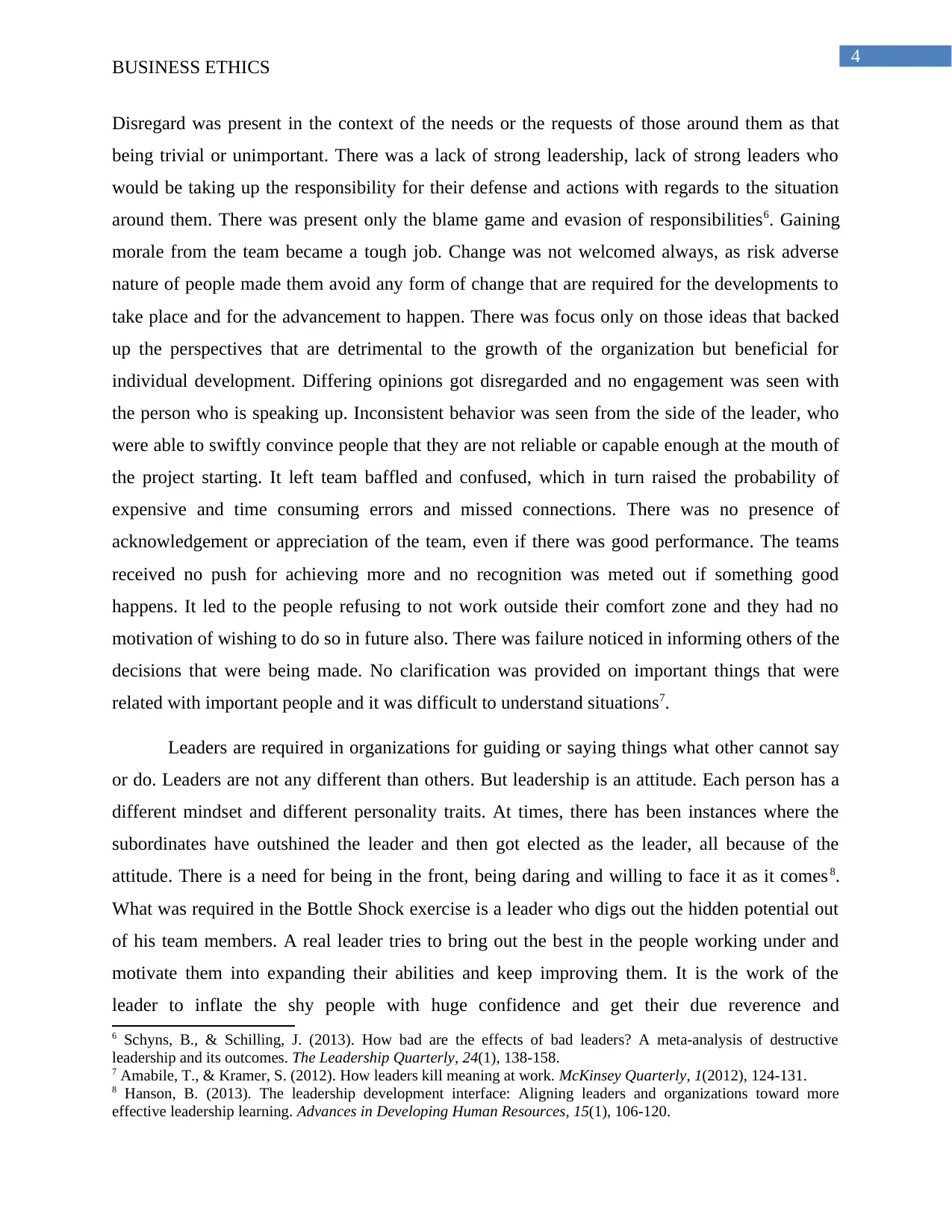
4
BUSINESS ETHICS
Disregard was present in the context of the needs or the requests of those around them as that
being trivial or unimportant. There was a lack of strong leadership, lack of strong leaders who
would be taking up the responsibility for their defense and actions with regards to the situation
around them. There was present only the blame game and evasion of responsibilities6. Gaining
morale from the team became a tough job. Change was not welcomed always, as risk adverse
nature of people made them avoid any form of change that are required for the developments to
take place and for the advancement to happen. There was focus only on those ideas that backed
up the perspectives that are detrimental to the growth of the organization but beneficial for
individual development. Differing opinions got disregarded and no engagement was seen with
the person who is speaking up. Inconsistent behavior was seen from the side of the leader, who
were able to swiftly convince people that they are not reliable or capable enough at the mouth of
the project starting. It left team baffled and confused, which in turn raised the probability of
expensive and time consuming errors and missed connections. There was no presence of
acknowledgement or appreciation of the team, even if there was good performance. The teams
received no push for achieving more and no recognition was meted out if something good
happens. It led to the people refusing to not work outside their comfort zone and they had no
motivation of wishing to do so in future also. There was failure noticed in informing others of the
decisions that were being made. No clarification was provided on important things that were
related with important people and it was difficult to understand situations7.
Leaders are required in organizations for guiding or saying things what other cannot say
or do. Leaders are not any different than others. But leadership is an attitude. Each person has a
different mindset and different personality traits. At times, there has been instances where the
subordinates have outshined the leader and then got elected as the leader, all because of the
attitude. There is a need for being in the front, being daring and willing to face it as it comes 8.
What was required in the Bottle Shock exercise is a leader who digs out the hidden potential out
of his team members. A real leader tries to bring out the best in the people working under and
motivate them into expanding their abilities and keep improving them. It is the work of the
leader to inflate the shy people with huge confidence and get their due reverence and
6 Schyns, B., & Schilling, J. (2013). How bad are the effects of bad leaders? A meta-analysis of destructive
leadership and its outcomes. The Leadership Quarterly, 24(1), 138-158.
7 Amabile, T., & Kramer, S. (2012). How leaders kill meaning at work. McKinsey Quarterly, 1(2012), 124-131.
8 Hanson, B. (2013). The leadership development interface: Aligning leaders and organizations toward more
effective leadership learning. Advances in Developing Human Resources, 15(1), 106-120.
BUSINESS ETHICS
Disregard was present in the context of the needs or the requests of those around them as that
being trivial or unimportant. There was a lack of strong leadership, lack of strong leaders who
would be taking up the responsibility for their defense and actions with regards to the situation
around them. There was present only the blame game and evasion of responsibilities6. Gaining
morale from the team became a tough job. Change was not welcomed always, as risk adverse
nature of people made them avoid any form of change that are required for the developments to
take place and for the advancement to happen. There was focus only on those ideas that backed
up the perspectives that are detrimental to the growth of the organization but beneficial for
individual development. Differing opinions got disregarded and no engagement was seen with
the person who is speaking up. Inconsistent behavior was seen from the side of the leader, who
were able to swiftly convince people that they are not reliable or capable enough at the mouth of
the project starting. It left team baffled and confused, which in turn raised the probability of
expensive and time consuming errors and missed connections. There was no presence of
acknowledgement or appreciation of the team, even if there was good performance. The teams
received no push for achieving more and no recognition was meted out if something good
happens. It led to the people refusing to not work outside their comfort zone and they had no
motivation of wishing to do so in future also. There was failure noticed in informing others of the
decisions that were being made. No clarification was provided on important things that were
related with important people and it was difficult to understand situations7.
Leaders are required in organizations for guiding or saying things what other cannot say
or do. Leaders are not any different than others. But leadership is an attitude. Each person has a
different mindset and different personality traits. At times, there has been instances where the
subordinates have outshined the leader and then got elected as the leader, all because of the
attitude. There is a need for being in the front, being daring and willing to face it as it comes 8.
What was required in the Bottle Shock exercise is a leader who digs out the hidden potential out
of his team members. A real leader tries to bring out the best in the people working under and
motivate them into expanding their abilities and keep improving them. It is the work of the
leader to inflate the shy people with huge confidence and get their due reverence and
6 Schyns, B., & Schilling, J. (2013). How bad are the effects of bad leaders? A meta-analysis of destructive
leadership and its outcomes. The Leadership Quarterly, 24(1), 138-158.
7 Amabile, T., & Kramer, S. (2012). How leaders kill meaning at work. McKinsey Quarterly, 1(2012), 124-131.
8 Hanson, B. (2013). The leadership development interface: Aligning leaders and organizations toward more
effective leadership learning. Advances in Developing Human Resources, 15(1), 106-120.
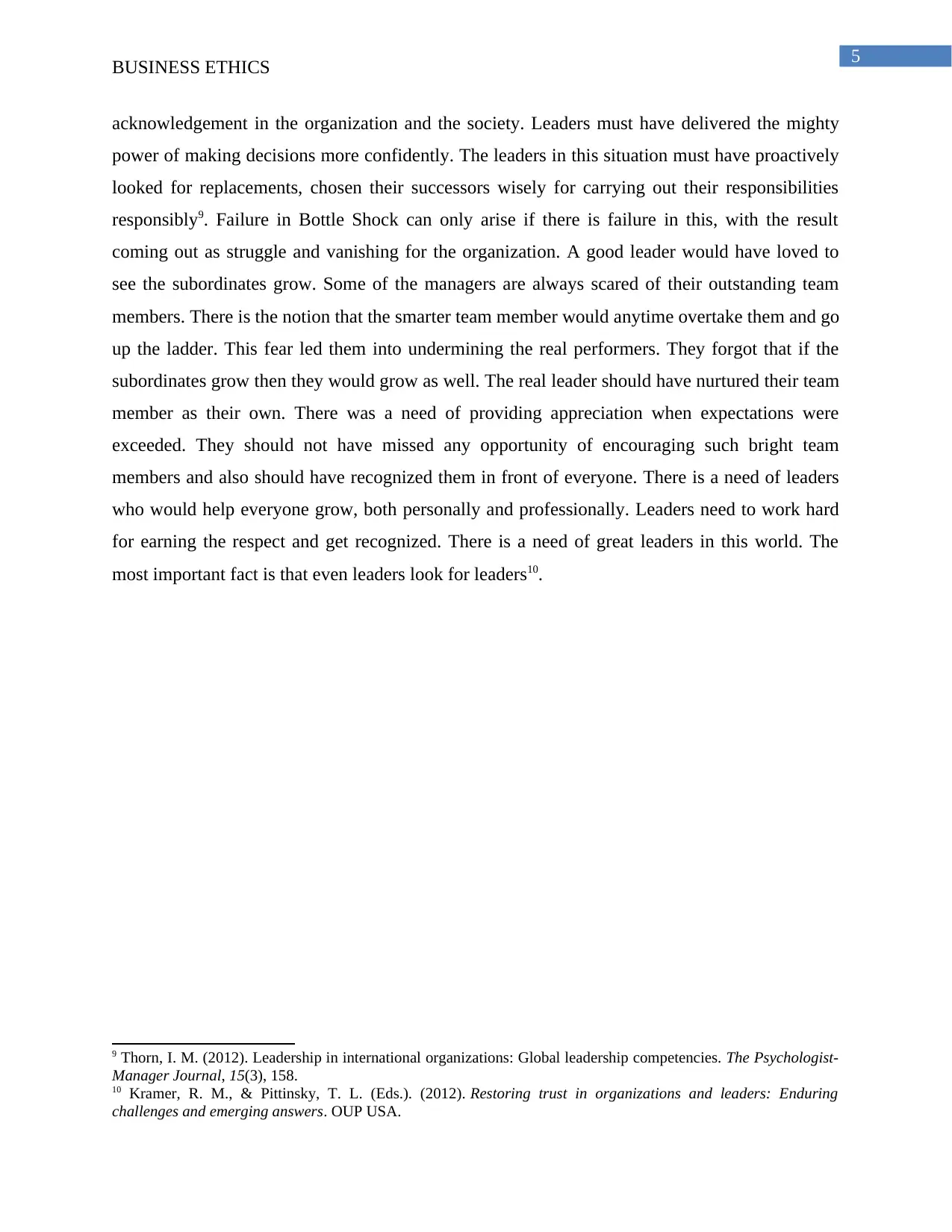
5
BUSINESS ETHICS
acknowledgement in the organization and the society. Leaders must have delivered the mighty
power of making decisions more confidently. The leaders in this situation must have proactively
looked for replacements, chosen their successors wisely for carrying out their responsibilities
responsibly9. Failure in Bottle Shock can only arise if there is failure in this, with the result
coming out as struggle and vanishing for the organization. A good leader would have loved to
see the subordinates grow. Some of the managers are always scared of their outstanding team
members. There is the notion that the smarter team member would anytime overtake them and go
up the ladder. This fear led them into undermining the real performers. They forgot that if the
subordinates grow then they would grow as well. The real leader should have nurtured their team
member as their own. There was a need of providing appreciation when expectations were
exceeded. They should not have missed any opportunity of encouraging such bright team
members and also should have recognized them in front of everyone. There is a need of leaders
who would help everyone grow, both personally and professionally. Leaders need to work hard
for earning the respect and get recognized. There is a need of great leaders in this world. The
most important fact is that even leaders look for leaders10.
9 Thorn, I. M. (2012). Leadership in international organizations: Global leadership competencies. The Psychologist-
Manager Journal, 15(3), 158.
10 Kramer, R. M., & Pittinsky, T. L. (Eds.). (2012). Restoring trust in organizations and leaders: Enduring
challenges and emerging answers. OUP USA.
BUSINESS ETHICS
acknowledgement in the organization and the society. Leaders must have delivered the mighty
power of making decisions more confidently. The leaders in this situation must have proactively
looked for replacements, chosen their successors wisely for carrying out their responsibilities
responsibly9. Failure in Bottle Shock can only arise if there is failure in this, with the result
coming out as struggle and vanishing for the organization. A good leader would have loved to
see the subordinates grow. Some of the managers are always scared of their outstanding team
members. There is the notion that the smarter team member would anytime overtake them and go
up the ladder. This fear led them into undermining the real performers. They forgot that if the
subordinates grow then they would grow as well. The real leader should have nurtured their team
member as their own. There was a need of providing appreciation when expectations were
exceeded. They should not have missed any opportunity of encouraging such bright team
members and also should have recognized them in front of everyone. There is a need of leaders
who would help everyone grow, both personally and professionally. Leaders need to work hard
for earning the respect and get recognized. There is a need of great leaders in this world. The
most important fact is that even leaders look for leaders10.
9 Thorn, I. M. (2012). Leadership in international organizations: Global leadership competencies. The Psychologist-
Manager Journal, 15(3), 158.
10 Kramer, R. M., & Pittinsky, T. L. (Eds.). (2012). Restoring trust in organizations and leaders: Enduring
challenges and emerging answers. OUP USA.
⊘ This is a preview!⊘
Do you want full access?
Subscribe today to unlock all pages.

Trusted by 1+ million students worldwide
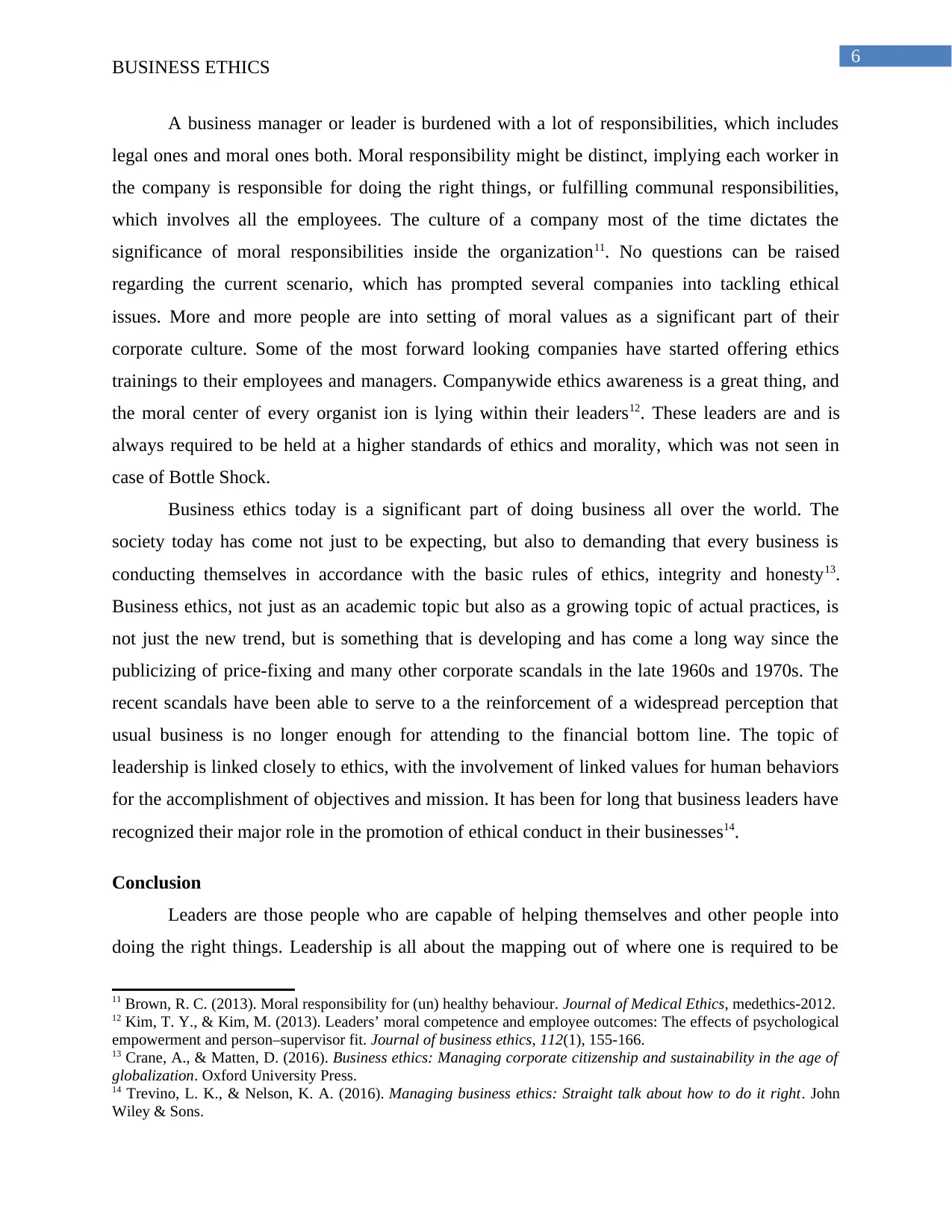
6
BUSINESS ETHICS
A business manager or leader is burdened with a lot of responsibilities, which includes
legal ones and moral ones both. Moral responsibility might be distinct, implying each worker in
the company is responsible for doing the right things, or fulfilling communal responsibilities,
which involves all the employees. The culture of a company most of the time dictates the
significance of moral responsibilities inside the organization11. No questions can be raised
regarding the current scenario, which has prompted several companies into tackling ethical
issues. More and more people are into setting of moral values as a significant part of their
corporate culture. Some of the most forward looking companies have started offering ethics
trainings to their employees and managers. Companywide ethics awareness is a great thing, and
the moral center of every organist ion is lying within their leaders12. These leaders are and is
always required to be held at a higher standards of ethics and morality, which was not seen in
case of Bottle Shock.
Business ethics today is a significant part of doing business all over the world. The
society today has come not just to be expecting, but also to demanding that every business is
conducting themselves in accordance with the basic rules of ethics, integrity and honesty13.
Business ethics, not just as an academic topic but also as a growing topic of actual practices, is
not just the new trend, but is something that is developing and has come a long way since the
publicizing of price-fixing and many other corporate scandals in the late 1960s and 1970s. The
recent scandals have been able to serve to a the reinforcement of a widespread perception that
usual business is no longer enough for attending to the financial bottom line. The topic of
leadership is linked closely to ethics, with the involvement of linked values for human behaviors
for the accomplishment of objectives and mission. It has been for long that business leaders have
recognized their major role in the promotion of ethical conduct in their businesses14.
Conclusion
Leaders are those people who are capable of helping themselves and other people into
doing the right things. Leadership is all about the mapping out of where one is required to be
11 Brown, R. C. (2013). Moral responsibility for (un) healthy behaviour. Journal of Medical Ethics, medethics-2012.
12 Kim, T. Y., & Kim, M. (2013). Leaders’ moral competence and employee outcomes: The effects of psychological
empowerment and person–supervisor fit. Journal of business ethics, 112(1), 155-166.
13 Crane, A., & Matten, D. (2016). Business ethics: Managing corporate citizenship and sustainability in the age of
globalization. Oxford University Press.
14 Trevino, L. K., & Nelson, K. A. (2016). Managing business ethics: Straight talk about how to do it right. John
Wiley & Sons.
BUSINESS ETHICS
A business manager or leader is burdened with a lot of responsibilities, which includes
legal ones and moral ones both. Moral responsibility might be distinct, implying each worker in
the company is responsible for doing the right things, or fulfilling communal responsibilities,
which involves all the employees. The culture of a company most of the time dictates the
significance of moral responsibilities inside the organization11. No questions can be raised
regarding the current scenario, which has prompted several companies into tackling ethical
issues. More and more people are into setting of moral values as a significant part of their
corporate culture. Some of the most forward looking companies have started offering ethics
trainings to their employees and managers. Companywide ethics awareness is a great thing, and
the moral center of every organist ion is lying within their leaders12. These leaders are and is
always required to be held at a higher standards of ethics and morality, which was not seen in
case of Bottle Shock.
Business ethics today is a significant part of doing business all over the world. The
society today has come not just to be expecting, but also to demanding that every business is
conducting themselves in accordance with the basic rules of ethics, integrity and honesty13.
Business ethics, not just as an academic topic but also as a growing topic of actual practices, is
not just the new trend, but is something that is developing and has come a long way since the
publicizing of price-fixing and many other corporate scandals in the late 1960s and 1970s. The
recent scandals have been able to serve to a the reinforcement of a widespread perception that
usual business is no longer enough for attending to the financial bottom line. The topic of
leadership is linked closely to ethics, with the involvement of linked values for human behaviors
for the accomplishment of objectives and mission. It has been for long that business leaders have
recognized their major role in the promotion of ethical conduct in their businesses14.
Conclusion
Leaders are those people who are capable of helping themselves and other people into
doing the right things. Leadership is all about the mapping out of where one is required to be
11 Brown, R. C. (2013). Moral responsibility for (un) healthy behaviour. Journal of Medical Ethics, medethics-2012.
12 Kim, T. Y., & Kim, M. (2013). Leaders’ moral competence and employee outcomes: The effects of psychological
empowerment and person–supervisor fit. Journal of business ethics, 112(1), 155-166.
13 Crane, A., & Matten, D. (2016). Business ethics: Managing corporate citizenship and sustainability in the age of
globalization. Oxford University Press.
14 Trevino, L. K., & Nelson, K. A. (2016). Managing business ethics: Straight talk about how to do it right. John
Wiley & Sons.
Paraphrase This Document
Need a fresh take? Get an instant paraphrase of this document with our AI Paraphraser
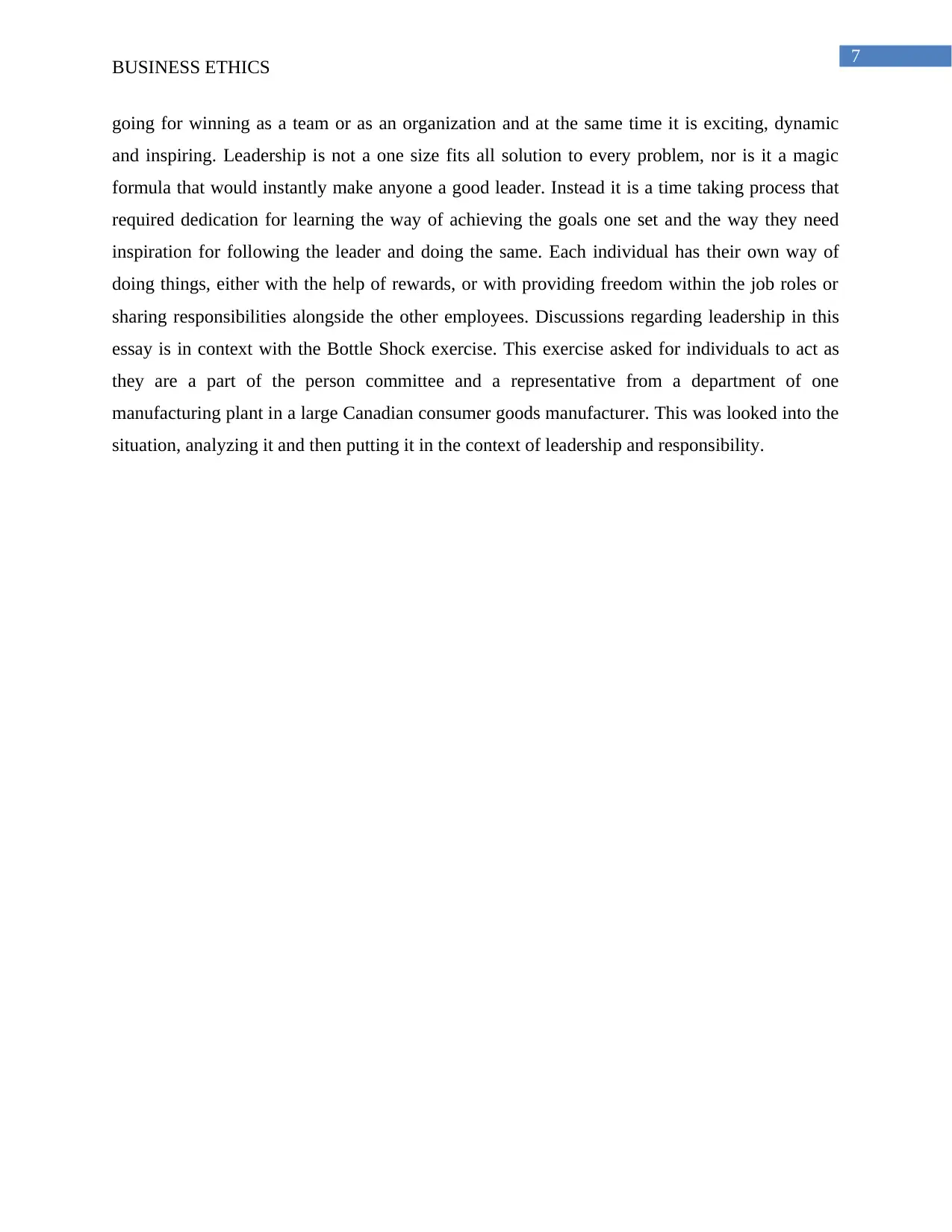
7
BUSINESS ETHICS
going for winning as a team or as an organization and at the same time it is exciting, dynamic
and inspiring. Leadership is not a one size fits all solution to every problem, nor is it a magic
formula that would instantly make anyone a good leader. Instead it is a time taking process that
required dedication for learning the way of achieving the goals one set and the way they need
inspiration for following the leader and doing the same. Each individual has their own way of
doing things, either with the help of rewards, or with providing freedom within the job roles or
sharing responsibilities alongside the other employees. Discussions regarding leadership in this
essay is in context with the Bottle Shock exercise. This exercise asked for individuals to act as
they are a part of the person committee and a representative from a department of one
manufacturing plant in a large Canadian consumer goods manufacturer. This was looked into the
situation, analyzing it and then putting it in the context of leadership and responsibility.
BUSINESS ETHICS
going for winning as a team or as an organization and at the same time it is exciting, dynamic
and inspiring. Leadership is not a one size fits all solution to every problem, nor is it a magic
formula that would instantly make anyone a good leader. Instead it is a time taking process that
required dedication for learning the way of achieving the goals one set and the way they need
inspiration for following the leader and doing the same. Each individual has their own way of
doing things, either with the help of rewards, or with providing freedom within the job roles or
sharing responsibilities alongside the other employees. Discussions regarding leadership in this
essay is in context with the Bottle Shock exercise. This exercise asked for individuals to act as
they are a part of the person committee and a representative from a department of one
manufacturing plant in a large Canadian consumer goods manufacturer. This was looked into the
situation, analyzing it and then putting it in the context of leadership and responsibility.
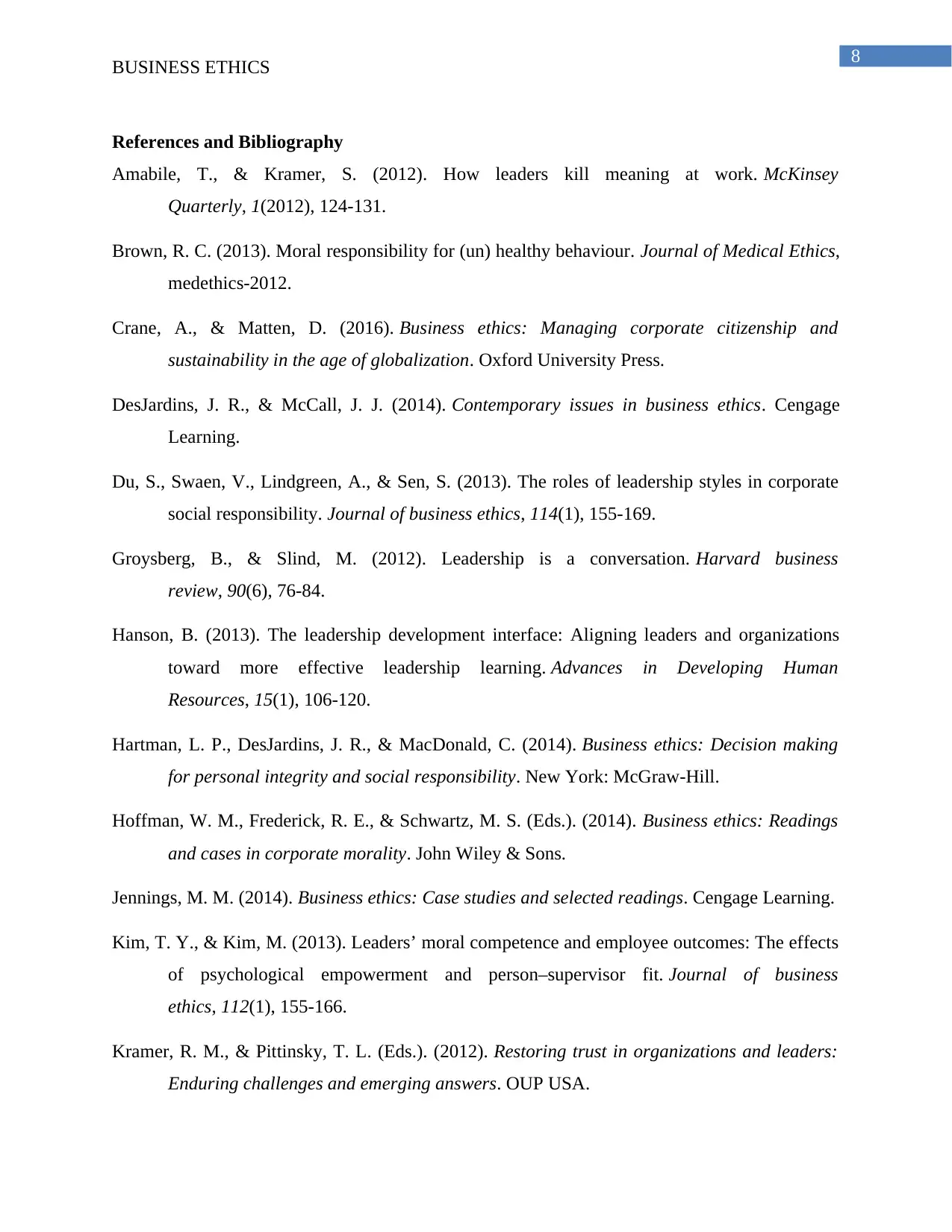
8
BUSINESS ETHICS
References and Bibliography
Amabile, T., & Kramer, S. (2012). How leaders kill meaning at work. McKinsey
Quarterly, 1(2012), 124-131.
Brown, R. C. (2013). Moral responsibility for (un) healthy behaviour. Journal of Medical Ethics,
medethics-2012.
Crane, A., & Matten, D. (2016). Business ethics: Managing corporate citizenship and
sustainability in the age of globalization. Oxford University Press.
DesJardins, J. R., & McCall, J. J. (2014). Contemporary issues in business ethics. Cengage
Learning.
Du, S., Swaen, V., Lindgreen, A., & Sen, S. (2013). The roles of leadership styles in corporate
social responsibility. Journal of business ethics, 114(1), 155-169.
Groysberg, B., & Slind, M. (2012). Leadership is a conversation. Harvard business
review, 90(6), 76-84.
Hanson, B. (2013). The leadership development interface: Aligning leaders and organizations
toward more effective leadership learning. Advances in Developing Human
Resources, 15(1), 106-120.
Hartman, L. P., DesJardins, J. R., & MacDonald, C. (2014). Business ethics: Decision making
for personal integrity and social responsibility. New York: McGraw-Hill.
Hoffman, W. M., Frederick, R. E., & Schwartz, M. S. (Eds.). (2014). Business ethics: Readings
and cases in corporate morality. John Wiley & Sons.
Jennings, M. M. (2014). Business ethics: Case studies and selected readings. Cengage Learning.
Kim, T. Y., & Kim, M. (2013). Leaders’ moral competence and employee outcomes: The effects
of psychological empowerment and person–supervisor fit. Journal of business
ethics, 112(1), 155-166.
Kramer, R. M., & Pittinsky, T. L. (Eds.). (2012). Restoring trust in organizations and leaders:
Enduring challenges and emerging answers. OUP USA.
BUSINESS ETHICS
References and Bibliography
Amabile, T., & Kramer, S. (2012). How leaders kill meaning at work. McKinsey
Quarterly, 1(2012), 124-131.
Brown, R. C. (2013). Moral responsibility for (un) healthy behaviour. Journal of Medical Ethics,
medethics-2012.
Crane, A., & Matten, D. (2016). Business ethics: Managing corporate citizenship and
sustainability in the age of globalization. Oxford University Press.
DesJardins, J. R., & McCall, J. J. (2014). Contemporary issues in business ethics. Cengage
Learning.
Du, S., Swaen, V., Lindgreen, A., & Sen, S. (2013). The roles of leadership styles in corporate
social responsibility. Journal of business ethics, 114(1), 155-169.
Groysberg, B., & Slind, M. (2012). Leadership is a conversation. Harvard business
review, 90(6), 76-84.
Hanson, B. (2013). The leadership development interface: Aligning leaders and organizations
toward more effective leadership learning. Advances in Developing Human
Resources, 15(1), 106-120.
Hartman, L. P., DesJardins, J. R., & MacDonald, C. (2014). Business ethics: Decision making
for personal integrity and social responsibility. New York: McGraw-Hill.
Hoffman, W. M., Frederick, R. E., & Schwartz, M. S. (Eds.). (2014). Business ethics: Readings
and cases in corporate morality. John Wiley & Sons.
Jennings, M. M. (2014). Business ethics: Case studies and selected readings. Cengage Learning.
Kim, T. Y., & Kim, M. (2013). Leaders’ moral competence and employee outcomes: The effects
of psychological empowerment and person–supervisor fit. Journal of business
ethics, 112(1), 155-166.
Kramer, R. M., & Pittinsky, T. L. (Eds.). (2012). Restoring trust in organizations and leaders:
Enduring challenges and emerging answers. OUP USA.
⊘ This is a preview!⊘
Do you want full access?
Subscribe today to unlock all pages.

Trusted by 1+ million students worldwide
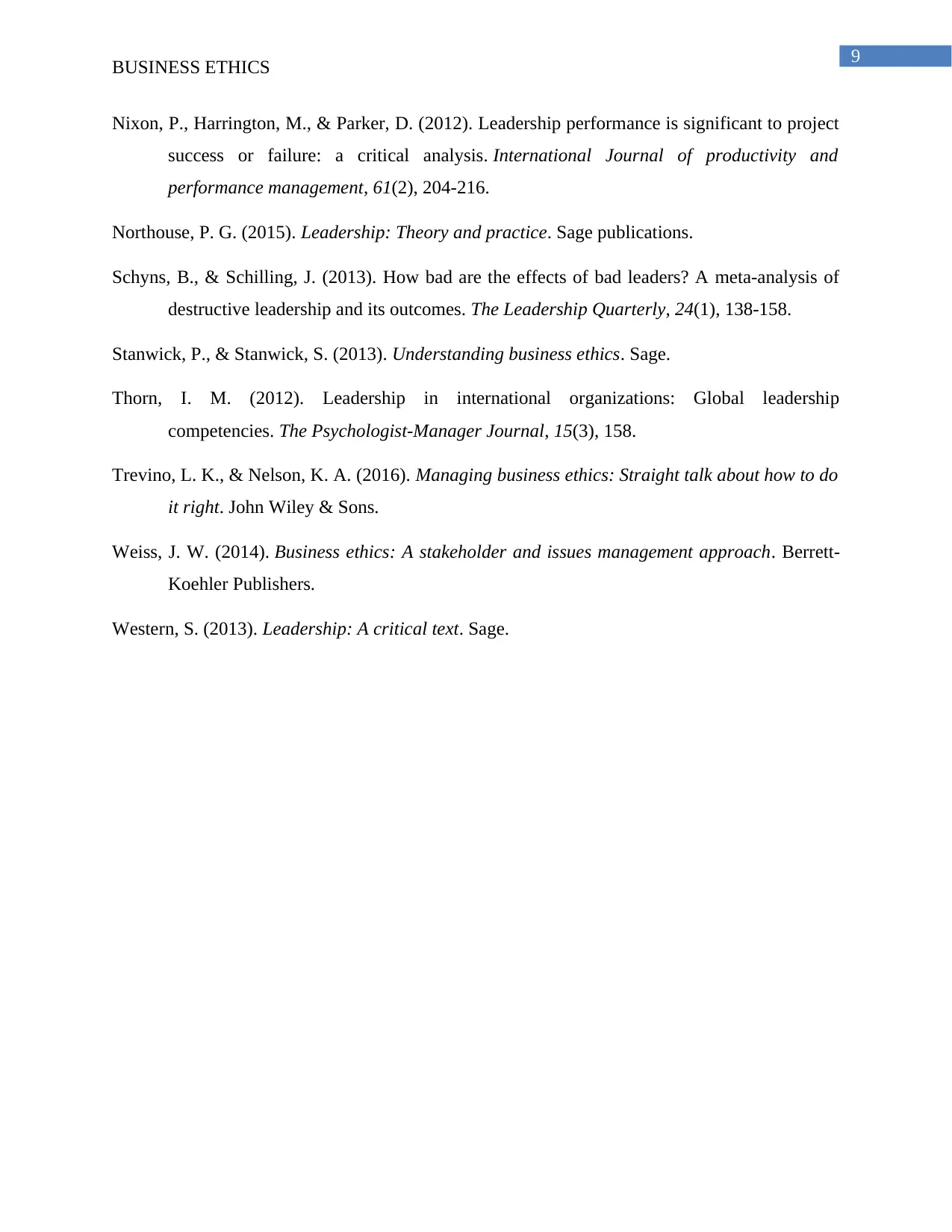
9
BUSINESS ETHICS
Nixon, P., Harrington, M., & Parker, D. (2012). Leadership performance is significant to project
success or failure: a critical analysis. International Journal of productivity and
performance management, 61(2), 204-216.
Northouse, P. G. (2015). Leadership: Theory and practice. Sage publications.
Schyns, B., & Schilling, J. (2013). How bad are the effects of bad leaders? A meta-analysis of
destructive leadership and its outcomes. The Leadership Quarterly, 24(1), 138-158.
Stanwick, P., & Stanwick, S. (2013). Understanding business ethics. Sage.
Thorn, I. M. (2012). Leadership in international organizations: Global leadership
competencies. The Psychologist-Manager Journal, 15(3), 158.
Trevino, L. K., & Nelson, K. A. (2016). Managing business ethics: Straight talk about how to do
it right. John Wiley & Sons.
Weiss, J. W. (2014). Business ethics: A stakeholder and issues management approach. Berrett-
Koehler Publishers.
Western, S. (2013). Leadership: A critical text. Sage.
BUSINESS ETHICS
Nixon, P., Harrington, M., & Parker, D. (2012). Leadership performance is significant to project
success or failure: a critical analysis. International Journal of productivity and
performance management, 61(2), 204-216.
Northouse, P. G. (2015). Leadership: Theory and practice. Sage publications.
Schyns, B., & Schilling, J. (2013). How bad are the effects of bad leaders? A meta-analysis of
destructive leadership and its outcomes. The Leadership Quarterly, 24(1), 138-158.
Stanwick, P., & Stanwick, S. (2013). Understanding business ethics. Sage.
Thorn, I. M. (2012). Leadership in international organizations: Global leadership
competencies. The Psychologist-Manager Journal, 15(3), 158.
Trevino, L. K., & Nelson, K. A. (2016). Managing business ethics: Straight talk about how to do
it right. John Wiley & Sons.
Weiss, J. W. (2014). Business ethics: A stakeholder and issues management approach. Berrett-
Koehler Publishers.
Western, S. (2013). Leadership: A critical text. Sage.
1 out of 10
Related Documents
Your All-in-One AI-Powered Toolkit for Academic Success.
+13062052269
info@desklib.com
Available 24*7 on WhatsApp / Email
![[object Object]](/_next/static/media/star-bottom.7253800d.svg)
Unlock your academic potential
Copyright © 2020–2025 A2Z Services. All Rights Reserved. Developed and managed by ZUCOL.




